transmission SSANGYONG MUSSO 2003 Service Manual
[x] Cancel search | Manufacturer: SSANGYONG, Model Year: 2003, Model line: MUSSO, Model: SSANGYONG MUSSO 2003Pages: 1574, PDF Size: 26.41 MB
Page 2 of 1574

0B-2 GENERAL INFORMATION661LA
4Cylinder
DIESEL 89
92.4
2299 22:1
101/4000
21.5/2400
Application
Engine Type Bore (mm) Stroke (mm)
Total Displacement (cc) Compression Ratio Maximum Power (ps/rpm)
Maximum Torque (kg.m/rpm)
Engine
662NA
5Cylinder
DIESEL 89
92.4
2874 22:1
95/4000
19.6/2400662LA
5Cylinder
DIESEL 89
92.4
2874 22:1
120/4000
25.5/24002.0L DOCH 4Cylinder
GASOLINE 89.9 78.7
19989.6:1
135/5500
19.3/40002.3L DOCH 4Cylinder
GASOLINE 90.9 88.4
2295
10.4:1
149/5500
22.4/40003.2L DOCH 6Cylinder
GASOLINE 89.9
84
3199 10:1
222/5500
31.6/3750
661LA
TREMEC
T5
3.969 2.341 1.457 1.0000.8513.705 4.55
3.4
Application
Ignition Type
Ignition Timing (BOTH)Ignition Sequence Spark Plug Gap (mm) Spark Plug Maker
Spark Plug Type Ignition System
Clutch - Manual Type 2.0L DOHC
6° ± 2°
1-3-4-2
0.8 ± 0.1
2.3L DOHC
6° ± 2°
1-3-4-2
0.8 ± 0.1 2.0L DOHC
8° ± 2°
1-5-3-6-2-4 0.8 ± 0.1
Distributorless Ignition Bosch, Chapion, Beru
F8DC4(BOSCH)
C11YCC(CHAMPION) 14F8DU4(BERU)
661LA 225 1509.2
662NA
225 1509.2 662LA
2401509.2 2.0L DOHC
2251509.2 2.3L DOHC
2251509.2 3.2L DOHC
2401559.3
Application
TypeOutside Diameter (mm) Inside Diameter (mm) ThicknessFluid
Single Dry Diaphram
Common use :Brake Fluid
Application
Maker
Type or Model
Gear Ratio : 1st 2nd3rd 4th 5thReverse
Final Drive RatioOil Capacity (L)
Manual Transmission
662NA
TREMEC
T5
3.969 2.341 1.457 1.0000.8513.705 4.55
3.4 662LA
TREMEC T5
3.9692.341 1.457 1.0000.8513.705 4.27
3.4 2.0L DOHC
TREMEC T5
3.9692.341 1.457 1.0000.8513.705 4.55
3.4 2.3L DOHC
TREMEC
T5
3.9692.341 1.457 1.0000.8513.705 4.55
3.4 3.2L DOHC
TREMEC T5
3.9692.341 1.457 1.0000.8513.705 3.73
3.4
Page 3 of 1574

GENERAL INFORMATION 0B-3
662LA MB
W4A040 3.871 2.247 1.4361.0005.5865.38
9 - 9.5
Auto Transmission (MB)
Application
Maker
Type or Model
Gear Ratio : 1st 2nd3rd 4th Reverse
Final Drive RatioOil Capacity (L)
2.3L DOHC MB
W4A040 3.871 2.247 1.4361.0005.5864.27
9 - 9.5 3.2L DOHC
MB
W4A040 3.871 2.247 1.4361.0005.5863.73
9 - 9.5
661LA
BTRA
M74 4WD
2.741 1.508 1.0000.7082.429
5.38 9
Auto Transmission (BTRA)
Application
Maker
Type or Model
Gear Ratio : 1st 2nd 3rd 4thReverse
Final Drive RatioOil Capacity (L)662LA BTRA
M74 4WD
2.741 1.508 1.0000.7082.429
4.89 9 2.3L DOHC
BTRA
M74 4WD
2.741 1.508 1.0000.7082.429
5.86 9 3.2L DOHC
BTRA
M74 4WD
2.741 1.508 1.0000.7082.429
4.89 9
Tire and Wheel
Specifications
P235/75 R15, 255/70 R15 7JJ × 15
30 Psi 30 Psi 30 Psi 30 Psi
Application
Standard Tire SizeStandard Wheel SizeInflation Pressure At Full Lode
P235 / 75 : FrontRear
P255 / 75 : Front Rear
Application
Booster Size Master Cylinder Diameter (mm) Booster Ratio
Front Brake : Disc Type
Rear Brake : Disc Type
Specifications 8inch + 9inch 7inch + 8inch 8inch + 9inch
� 25.4
5.6 : 1
Ventilated
Solid
Brake
non-ABS ABS 5.0ABS 5.3
Page 9 of 1574
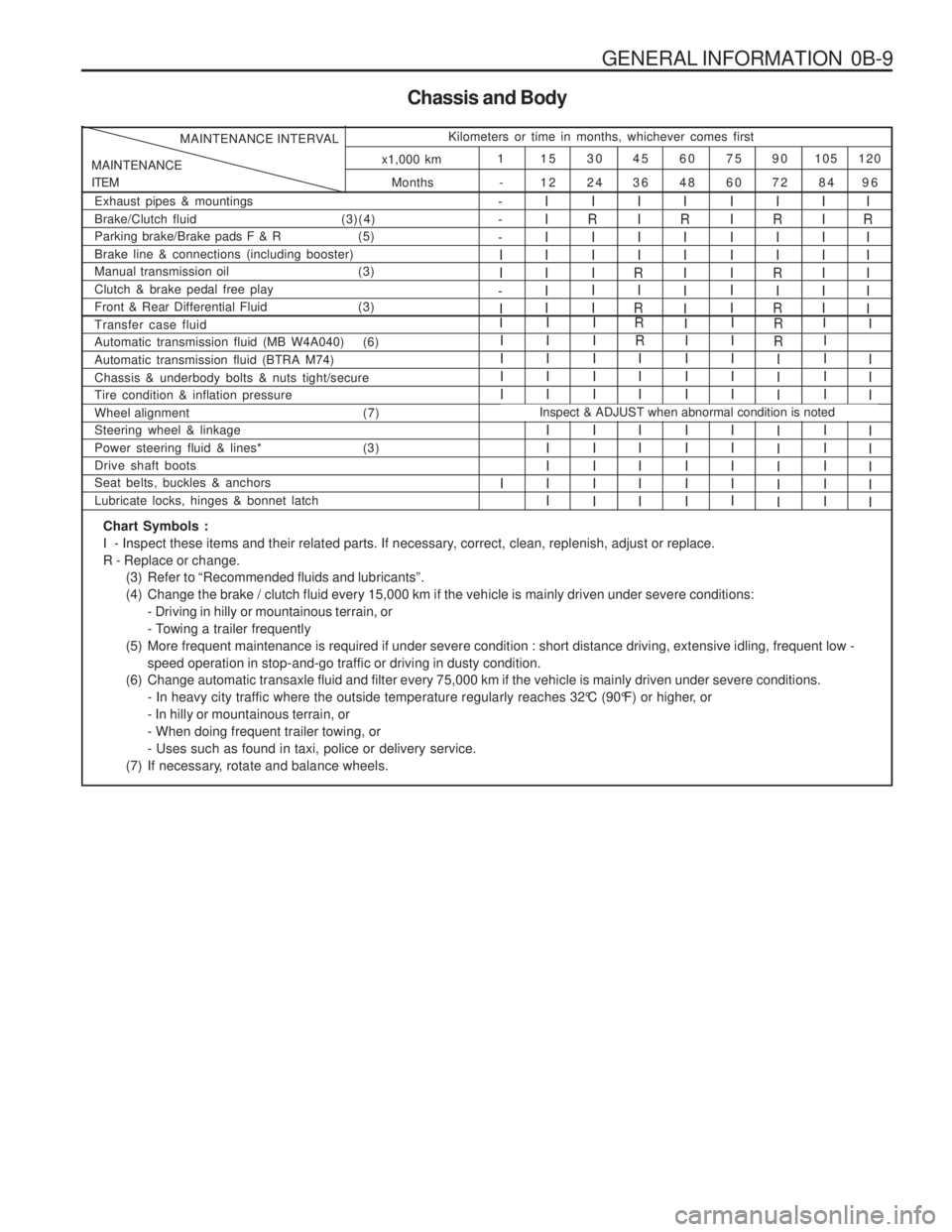
GENERAL INFORMATION 0B-9
Chassis and Body
Months
MAINTENANCE ITEM MAINTENANCE INTERVAL
Kilometers or time in months, whichever comes first
120
105
90
75
60
45
30
15
1
96
84
72
60
48
36
24
12
-
x1,000 km
Exhaust pipes & mountings Brake/Clutch fluid
(3)(4)
Parking brake/Brake pads F & R (5)Brake line & connections (including booster)
Manual transmission oil (3) Clutch & brake pedal free play
Front & Rear Differential Fluid (3)I
R
IIIII- --II
-
I IIIIII I
I
R I II I I IIII
R I
R IIIII I II
R
II
R I
R IIIIII II
R I IIII
Automatic transmission fluid (MB W4A040) (6) Automatic transmission fluid (BTRA M74)Chassis & underbody bolts & nuts tight/secure Tire condition & inflation pressure
Wheel alignment (7) Steering wheel & linkage
Power steering fluid & lines* (3)Drive shaft boots Seat belts, buckles & anchors Lubricate locks, hinges & bonnet latchIIII I I IIII I III I I IIII I IIII
R
III I IIII IIII I IIIIIIIII I III I
R R
III I IIII IIII I IIII
Transfer case fluidRII
I
Inspect & ADJUST when abnormal condition is noted
I
I II I IIII
Chart Symbols :
I - Inspect these items and their related parts. If necessary, correct, clean, replenish, adjust or replace.R - Replace or change.
(3) Refer to “Recommended fluids and lubricants”.
(4) Change the brake / clutch fluid every 15,000 km if the vehicle is mainly driven under severe conditions:- Driving in hilly or mountainous terrain, or
- Towing a trailer frequently
(5) More frequent maintenance is required if under severe condition : short distance driving, extensive idling, frequent low - speed operation in stop-and-go traffic or driving in dusty condition.
(6) Change automatic transaxle fluid and filter every 75,000 km if the vehicle is mainly driven under severe conditions. - In heavy city traffic where the outside temperature regularly reaches 32°C (90°F) or higher, or- In hilly or mountainous terrain, or- When doing frequent trailer towing, or- Uses such as found in taxi, police or delivery service.
(7) If necessary, rotate and balance wheels.
Page 11 of 1574
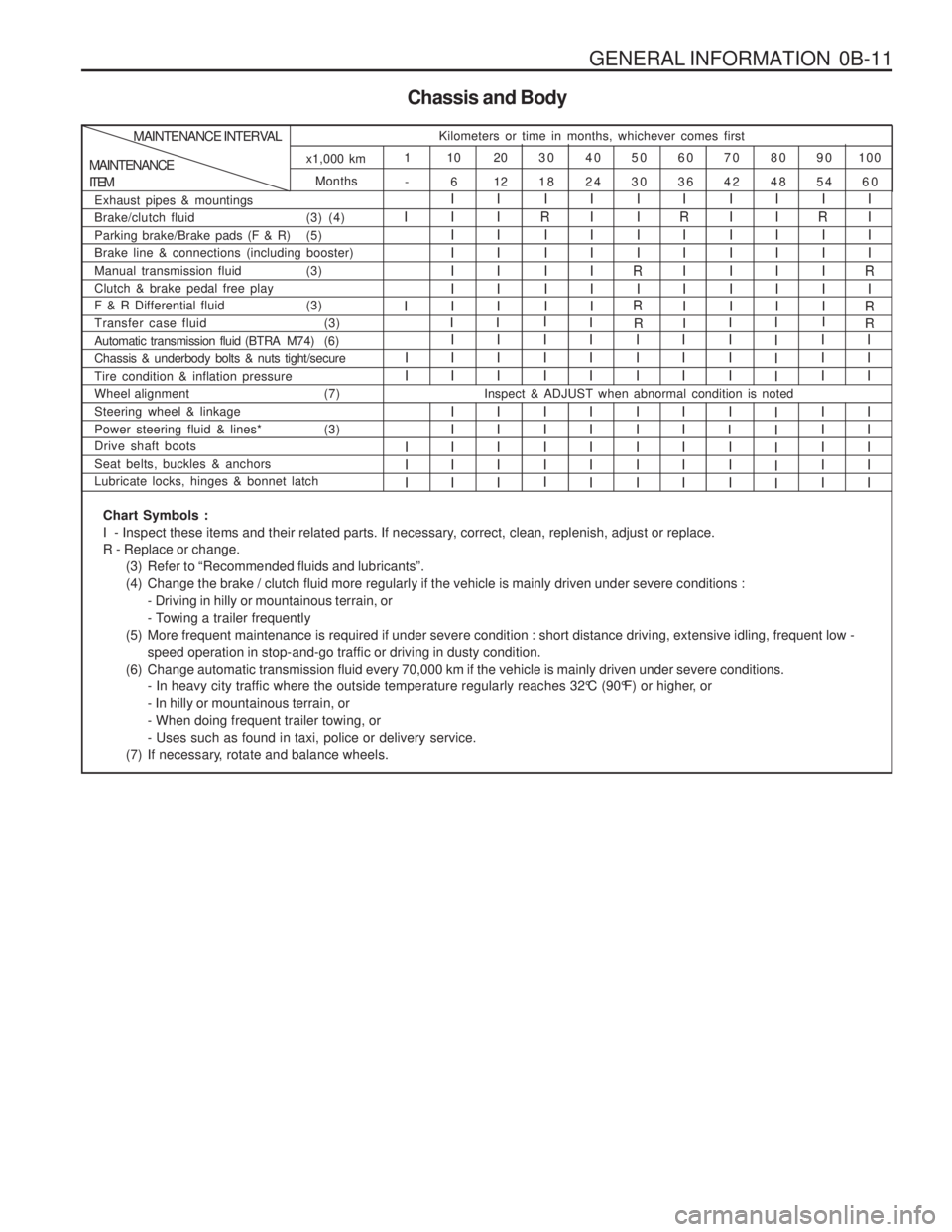
GENERAL INFORMATION 0B-11
Chassis and Body
Months -
MAINTENANCE ITEMMAINTENANCE INTERVAL
Kilometers or time in months, whichever comes first
100
90
80
70
60
50
40
30
20
10
1
60
54
48
42
36
30
24
18
12
6
x1,000 km
Exhaust pipes & mountings
Brake/clutch fluid (3) (4)
Parking brake/Brake pads (F & R) (5) Brake line & connections (including booster)
Manual transmission fluid (3)Clutch & brake pedal free play
F & R Differential fluid (3)
I I I IIIIIIIIIIIII I
R
IIIII IIIIIII IIII
R I
R I
R
IIIII IIIIIIIIIIIIII I
R
IIIII IIII
R I
R
Automatic transmission fluid (BTRA M74) (6) Chassis & underbody bolts & nuts tight/secure Tire condition & inflation pressure
Wheel alignment (7) Steering wheel & linkage
Power steering fluid & lines* (3) Drive shaft boots Seat belts, buckles & anchors Lubricate locks, hinges & bonnet latchI II I IIII III I IIII IIII I III I
I II I IIII III I IIIIIII I IIII III II II III I IIIIIII I IIII
Transfer case fluid (3)
RI R
I
I
I
I I I II IIII I IIII
Inspect & ADJUST when abnormal condition is noted
II I
Chart Symbols :
I - Inspect these items and their related parts. If necessary, correct, clean, replenish, adjust or replace.R - Replace or change.
(3) Refer to “Recommended fluids and lubricants”.
(4) Change the brake / clutch fluid more regularly if the vehicle is mainly driven under severe conditions :- Driving in hilly or mountainous terrain, or
- Towing a trailer frequently
(5) More frequent maintenance is required if under severe condition : short distance driving, extensive idling, frequent low - speed operation in stop-and-go traffic or driving in dusty condition.
(6) Change automatic transmission fluid every 70,000 km if the vehicle is mainly driven under severe conditions. - In heavy city traffic where the outside temperature regularly reaches 32°C (90°F) or higher, or- In hilly or mountainous terrain, or- When doing frequent trailer towing, or- Uses such as found in taxi, police or delivery service.
(7) If necessary, rotate and balance wheels.
Page 26 of 1574

GENERAL ENGINE INFORMATION 1A1-7
OIL LEAK DIAGNOSIS Most fluid oil leaks are easily located and repaired by visually finding the leak and replacing or repairing thenecessary parts. On some occasions a fluid leak may
be difficult to locate or repair. The following proceduresmay help you in locating and repairing most leaks. Finding the Leak
1. Identify the fluid. Determine whether it is engine oil,automatic transmission fluid, power steering fluid, etc.
2. Identify where the fluid is leaking from. 2.1 After running the vehicle at normal operating temperature, park the vehicle over a large sheet
of paper.
2.2 Wait a few minutes.
2.3 You should be able to find the approximate location of the leak by the drippings on the
paper.
3. Visually check around the suspected component. Check around all the gasket mating surfaces forleaks. A mirror is useful for finding leaks in areas thatare hard to reach.
4. If the leak still cannot be found, it may be necessary to clean the suspected area with a degreaser, steamor spray solvent.
4.1 Clean the area well.
4.2 Dry the area.
4.3 Operate the vehicle for several miles at normal operating temperature and varying speeds.
4.4 After operating the vehicle, visually check the suspected component.
4.5 If you still cannot locate the leak, try using the powder or black light and dye method.
Powder Method
1. Clean the suspected area.
2. Apply an aerosol-type powder (such as foot powder) to the suspected area.
3. Operate the vehicle under normal operating conditoins.
4. Visually inspect the suspected component. You should be able to trace the leak path over the white powder surface to the source.
Black Light and Dye Method A dye and light kit is available for finding leaks, Refer to the manufacturer's directions when using the kit.
1. Pour the specified amount of dye into the engine oil fill tube. 2. Operate the vehicle normal operating conditions as
directed in the kit.
3. Direct the light toward the suspected area. The dyed fluid will appear as a yellow path leading to the source.
Repairing the Leak Once the origin of the leak has been pinpointed and traced back to its source, the cause of the leak must be
determined n order for it to be repaired properly. If agasket is replaced, but the sealing flange is bent, the new gasket will not repair the leak. The bent flange must be repaired also. Before attempting to repair a leak,check for the following conditions and correct them asthey may cause a leak. Gaskets
� The fluid level/pressure is too high.
� The crankcase ventilation system is malfunctioning.
� The fasteners are tightened improperly or the threads are dirty or damaged.
� The flanges or the sealing surface is warped.
� There are scratches, burrs or other damage to thesealing surface.
� The gasket is damaged or worn.
� There is cracking or porosity of the component.
� An improper seal was used (where applicable).
Seals
� The fluid level/pressure is too high.
� The crankcase ventilation system is malfunctioning.
� The seal bore is damaged (scratched, burred or nicked).
� The seal is damaged or worn.
� Improper installation is evident.
� There are cracks in the components.
� The shaft surface is scratched, nicked or damaged.
� A loose or worn bearing is causing excess seal wear.
DIAGNOSIS
Page 38 of 1574
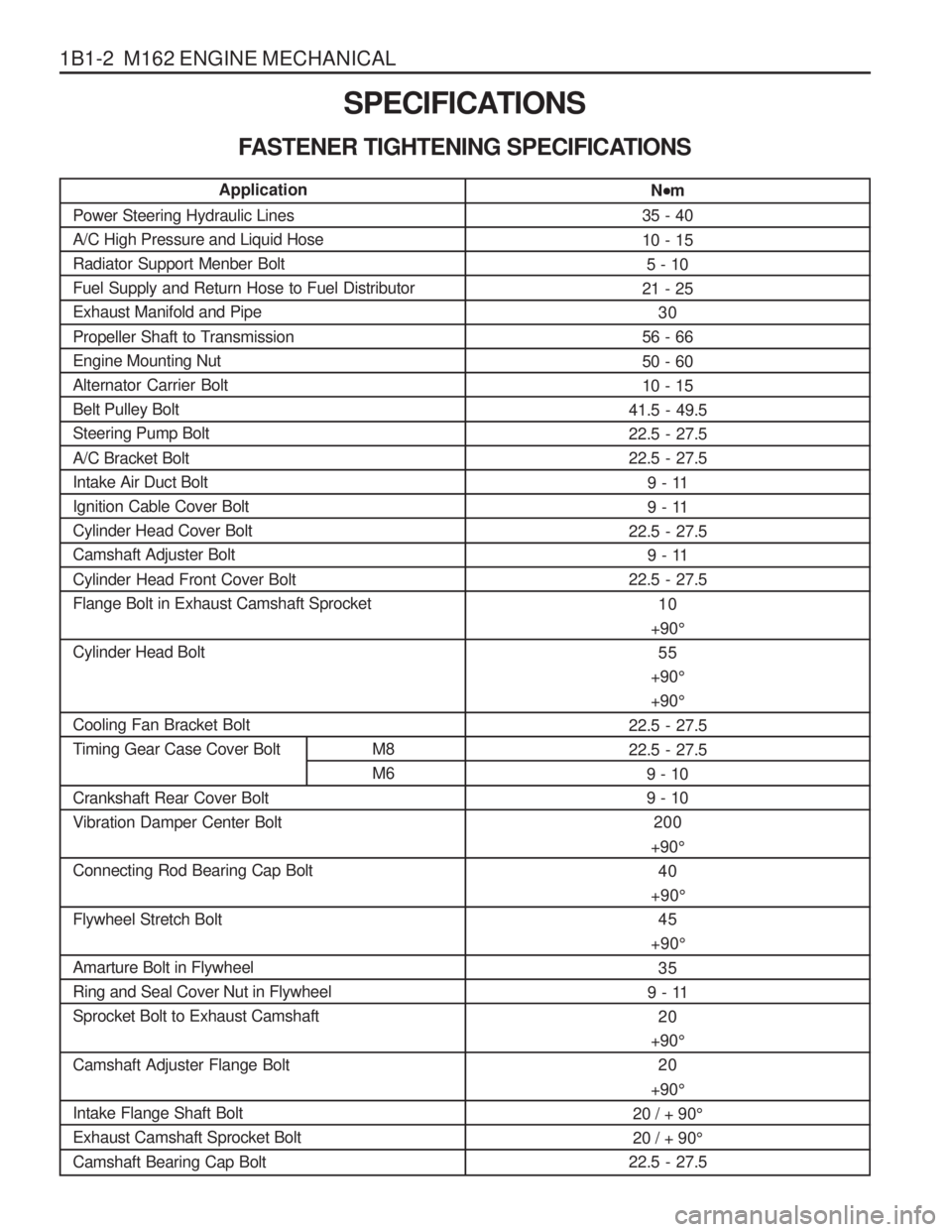
1B1-2 M162 ENGINE MECHANICALSPECIFICATIONS
FASTENER TIGHTENING SPECIFICATIONS N
m
35 - 40 10 - 15 5 - 10
21 - 25 30
56 - 6650 - 60 10 - 15
41.5 - 49.522.5 - 27.522.5 - 27.5
9 - 11
9 - 11
22.5 - 27.5
9 - 11
22.5 - 27.5
10
+90 °
55
+90 °
+90 °
22.5 - 27.522.5 - 27.5 9 - 109 - 10200
+90 °
40
+90 °
45
+90 °
35
9 - 11 20
+90 °
20
+90 °
20 / + 90 °
20 / + 90 °
22.5 - 27.5
Application
Power Steering Hydraulic Lines A/C High Pressure and Liquid HoseRadiator Support Menber BoltFuel Supply and Return Hose to Fuel DistributorExhaust Manifold and Pipe
Propeller Shaft to Transmission Engine Mounting NutAlternator Carrier BoltBelt Pulley BoltSteering Pump Bolt A/C Bracket Bolt Intake Air Duct BoltIgnition Cable Cover BoltCylinder Head Cover BoltCamshaft Adjuster Bolt Cylinder Head Front Cover Bolt Flange Bolt in Exhaust Camshaft Sprocket Cylinder Head Bolt Cooling Fan Bracket Bolt
Timing Gear Case Cover Bolt M8 M6
Crankshaft Rear Cover BoltVibration Damper Center Bolt Connecting Rod Bearing Cap Bolt Flywheel Stretch Bolt Amarture Bolt in Flywheel Ring and Seal Cover Nut in FlywheelSprocket Bolt to Exhaust Camshaft Camshaft Adjuster Flange Bolt Intake Flange Shaft Bolt Exhaust Camshaft Sprocket Bolt Camshaft Bearing Cap Bolt
Page 47 of 1574
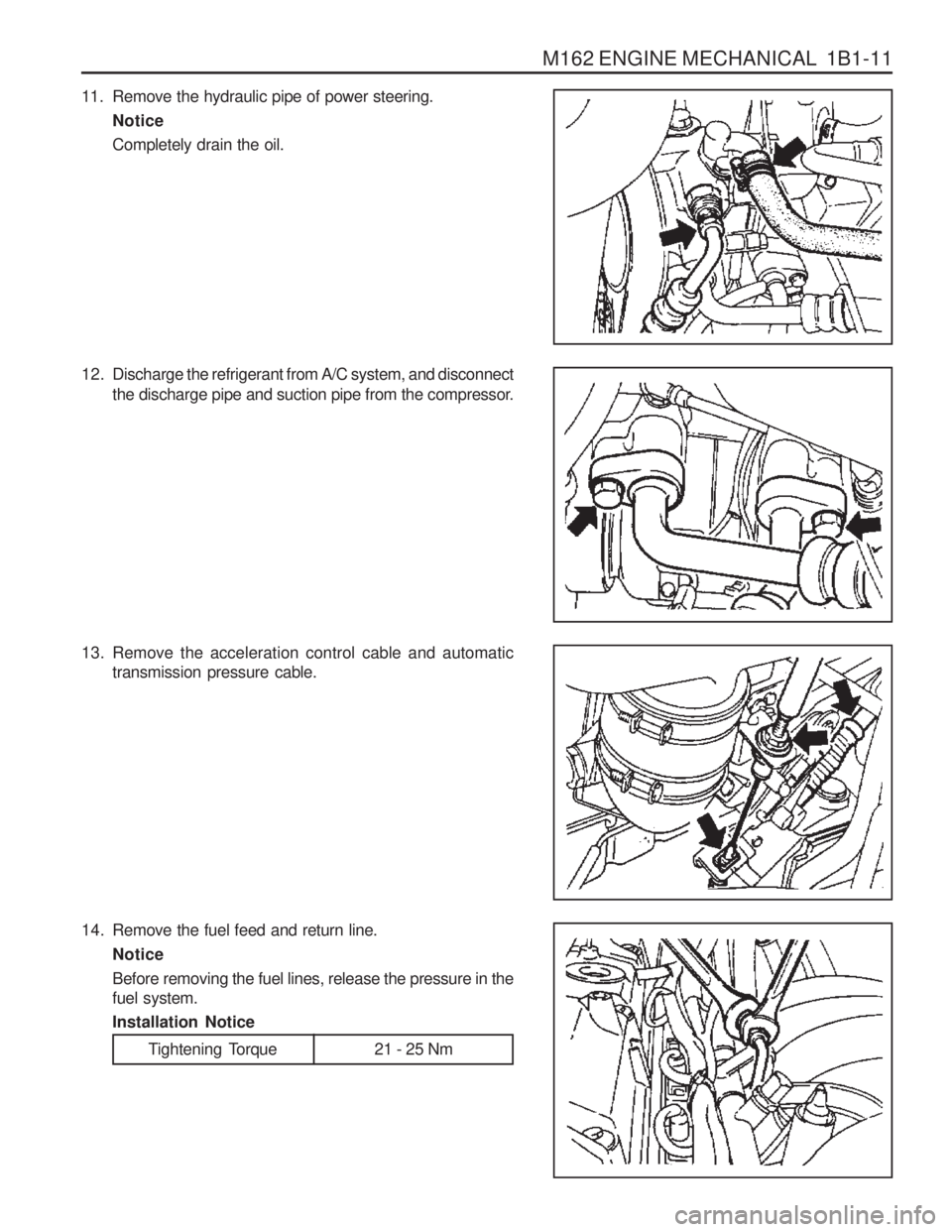
M162 ENGINE MECHANICAL 1B1-11
12. Discharge the refrigerant from A/C system, and disconnectthe discharge pipe and suction pipe from the compressor.
14. Remove the fuel feed and return line. Notice Before removing the fuel lines, release the pressure in the fuel system. Installation Notice
13. Remove the acceleration control cable and automatic
transmission pressure cable.
11. Remove the hydraulic pipe of power steering.
NoticeCompletely drain the oil.
Tightening Torque 21 - 25 Nm
Page 48 of 1574
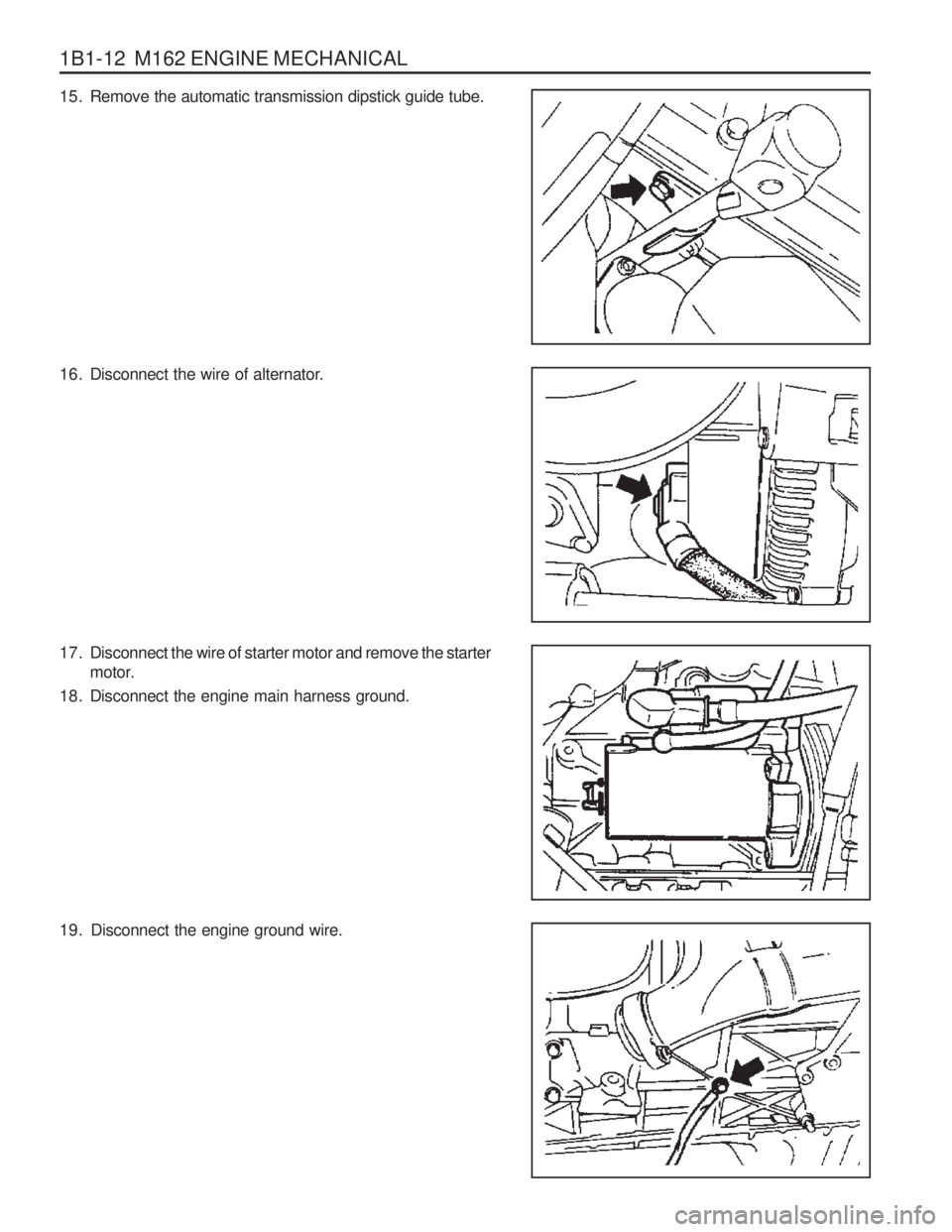
1B1-12 M162 ENGINE MECHANICAL
19. Disconnect the engine ground wire.
15. Remove the automatic transmission dipstick guide tube.
16. Disconnect the wire of alternator.
17. Disconnect the wire of starter motor and remove the starter
motor.
18. Disconnect the engine main harness ground.
Page 49 of 1574
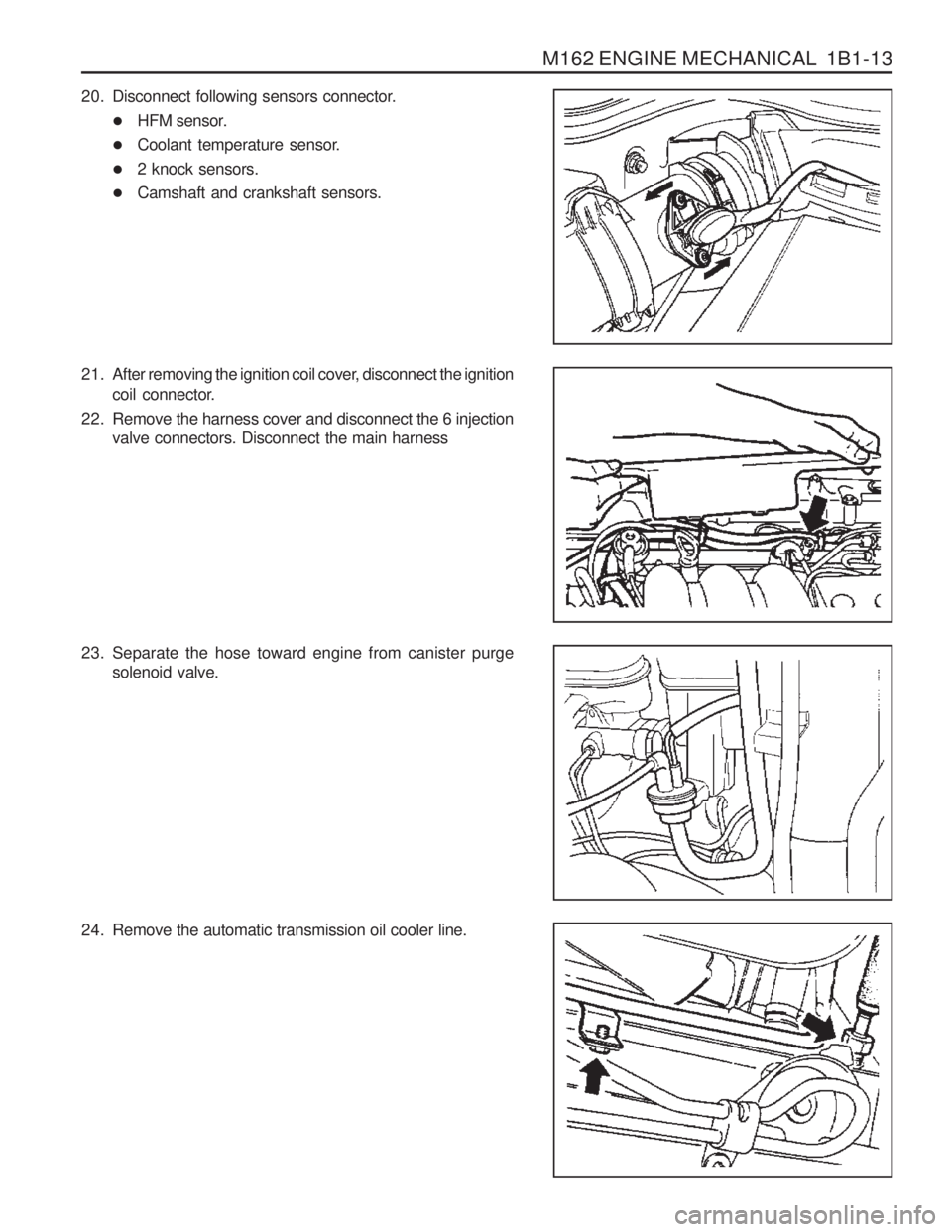
M162 ENGINE MECHANICAL 1B1-13
20. Disconnect following sensors connector.�HFM sensor.
� Coolant temperature sensor.
� 2 knock sensors.
� Camshaft and crankshaft sensors.
21. After removing the ignition coil cover, disconnect the ignition coil connector.
22. Remove the harness cover and disconnect the 6 injection valve connectors. Disconnect the main harness
23. Separate the hose toward engine from canister purge solenoid valve.
24. Remove the automatic transmission oil cooler line.
Page 51 of 1574

M162 ENGINE MECHANICAL 1B1-15
30. Remove the transmission mounting bolts and separatethe transmission from the engine. Installation Notice
Tightening Torque 65 Nm
31. Remove the bolts for engine mounting bracket. Installation Notice
Tightening Torque 50 - 75 Nm
32. Hook the chain to the bracket of engine and by using a hoist or crane, carefully separate the engine assembly from the vehicle.
33. Installation should follow the removal procedure in the reverse order.